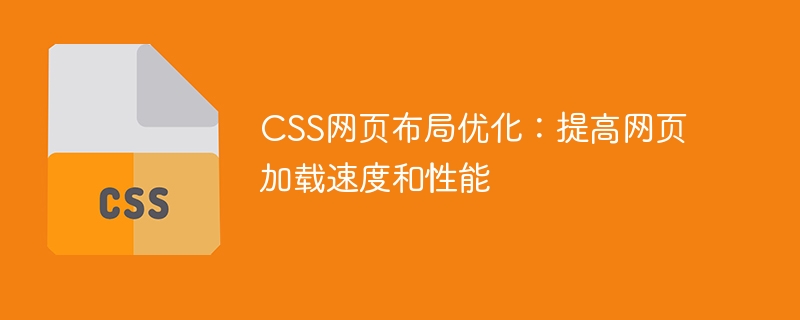Home >Web Front-end >CSS Tutorial >CSS web page layout optimization: improve web page loading speed and performance
CSS web page layout optimization: improve web page loading speed and performance
- WBOYWBOYWBOYWBOYWBOYWBOYWBOYWBOYWBOYWBOYWBOYWBOYWBOriginal
- 2023-11-18 17:35:281051browse

CSS web page layout optimization: To improve web page loading speed and performance, specific code examples are required
With the development of the Internet, users have higher and higher requirements for web page loading speed and performance. Come higher and higher. For web developers, optimizing web page layout is an important part of improving web page loading speed and performance. In this article, we’ll share some practical CSS optimization tips and provide concrete code examples.
- Choose the appropriate layout method
The appropriate layout method can reduce the rendering time of the web page. Among them, Flexbox layout (Flexbox) and Grid layout (Grid) are two commonly used layout methods at present. Not only are they easy to use, they also enable complex layout effects. The following is a simple flexbox layout example:
.container {
display: flex;
justify-content: center;
align-items: center;
}
.item {
flex: 1;
margin: 10px;
}- Compress and merge CSS files
Compressing and merging CSS files can reduce the number of HTTP requests, thereby improving page loading speed . Various tools such as CSSNano or UglifyCSS can be used to automatically compress and merge CSS files. The following is an example of using Grunt automation tool for CSS compression and merging:
module.exports = function(grunt) {
grunt.initConfig({
cssmin: {
target: {
files: {
'dist/minified.css': ['src/style1.css', 'src/style2.css']
}
}
}
});
grunt.loadNpmTasks('grunt-contrib-cssmin');
grunt.registerTask('default', ['cssmin']);
};- Using CSS preprocessor
CSS preprocessor can help us write more concise, modular and Maintainable CSS code. Common CSS preprocessors include Less, Sass, and Stylus. They provide variables, nested rules, functions and other functions, which can greatly simplify the development process. Here is an example written in Sass:
$primary-color: #007bff;
.main-container {
background-color: $primary-color;
.header {
font-size: 24px;
color: white;
}
.content {
padding: 20px;
}
.footer {
margin-top: 10px;
text-align: center;
}
}- Avoid using expensive CSS selectors
Overly complex or deeply nested CSS selectors will increase the complexity of page rendering. Causing the page to load slower. Therefore, we should try to avoid using expensive CSS selectors. For example, use a class selector instead of an attribute selector, use an ID selector instead of a tag selector, or simplify selectors by reducing nesting levels. - Using CSS animations and transitions
CSS animations and transitions can create a smooth and rich user experience in web pages. However, excessive or complex animations can impact web page performance. To improve performance, we should minimize the number and complexity of animations and use CSS3’s hardware acceleration capabilities. The following is a simple CSS transition example:
.box {
width: 100px;
height: 100px;
background-color: red;
transition: width 1s, height 1s;
}
.box:hover {
width: 200px;
height: 200px;
}In summary, by choosing the appropriate layout method, compressing and merging CSS files, using CSS preprocessors, and avoiding expensive CSS selectors As well as optimizing the use of CSS animations and transitions, we can effectively improve the loading speed and performance of web pages. I hope that the above specific code examples can help you carry out corresponding optimization work in actual development.
The above is the detailed content of CSS web page layout optimization: improve web page loading speed and performance. For more information, please follow other related articles on the PHP Chinese website!
Related articles
See more- What should I do if the high performance of win10 power supply is missing?
- How to optimize web page loading speed using Vue and Element-UI
- How to use CSS Flex elastic layout to optimize the loading speed of mobile web pages
- CSS Positions Layout Optimization Guide: Tips to Improve Web Page Loading Speed

